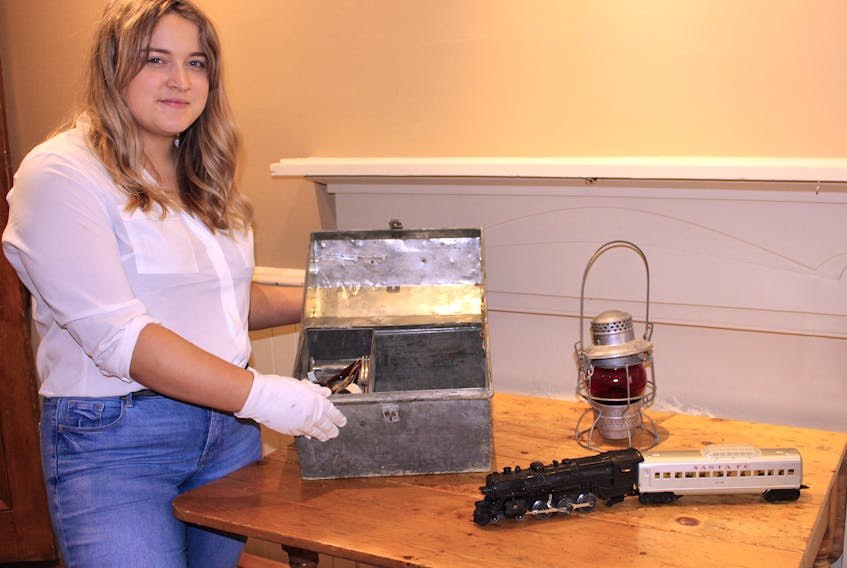SACKVILLE, N.B. — The story of Sackville’s railway and its integral role in the community over the past 150 years will be brought to life in a new exhibit opening this week at Boultenhouse Heritage Centre.
The exhibit, entitled ‘150 Years Living by the Rail’, will launch during the Fall Fair celebrations this weekend and will mark the anniversary of the Intercolonial Railway’s arrival in Sackville.

The first train came to Sackville on Nov. 30, 1869 – a milestone which caused a lot of excitement back then, said Kathy Bouska, one of the Tantramar Heritage Trust board members who has been integral in putting this exhibit together.
“For Sackville, this was really significant,” said Bouska.
In the 19th century, the railway served not only as a vital link for connecting small communities with each other and with larger centres, but for transporting goods and promoting trade.
“A lot of the industries here grew because of it,” she said. “It completely changed the destiny of Sackville.”
The exhibit, which will feature a large number of photos, artefacts and other memorabilia from the past 150 years of train and rail history in the Sackville area, will provide guests with a sense of what it might have been like to ride the rails in the 19th century while also giving an idea of how the crews lived on board, at a time when kerosene lamps and three-day tin lunchboxes were used and “everything was very labour intensive.”
Bouska said visitors can expect many surprises in the exhibit, pointing out “we have a some really great gems out there from the Intercolonial Railway,” as well as from local residents who have their own stories to tell or memories to relate about riding the trains. There will also be an interactive display or two for children, such as a train model from 1953 on loan from THT board member Al Smith.
Michelle Roy, a student intern who worked for the Tantramar Heritage Trust this summer, led a team of students throughout the past few months in doing the necessary background research and putting together the archival materials for the exhibit.
Roy, who is earning a degree in history and museum and curatorial studies at Mount Allison University, said she spent a lot of time collecting and sorting through old photos – ones she had gotten from the Canadian history database, the New Brunswick Railway Museum, books, Mount Alllison archives and local residents.
Among some of the other artefacts Roy was able to glean for the upcoming exhibit, one item she is particularly proud of obtaining is a penny from the notorious ‘Penny Wreck.’
It was a cold day in late January 1897 when a Canadian Pacific Railway train, carrying a shipment of about 900,000 newly-minted Canadian one-cent coins, left Halifax at 7 a.m., bound for Montreal. The coins were stowed away in the mail express car behind the engine.
The train arrived uneventfully in Sackville but as it made its way towards Dorchester and down a steep grade and around a sharp curve around Palmer’s Pond, the mail car jumped the rails, which then derailed the cars behind it. After running along the wood ties for another 150 feet, the cars then plunged down a 25-foot embankment and onto the frozen pond.
“Luckily, it was winter and the pond was frozen so no one drowned,” said Roy.
The mail car had ended up upside down on the frozen ice and about 50 cases of pennies were now broken with their contents spread out all over the ice. Although the majority of pennies were recovered from the wreck, many curious onlookers were able to pick up a shiny new souvenir of the accident at the time.
The Boultenhouse exhibit is part of a series of events being held this year to celebrate this 150th anniversary of the train in Sackville. Live Bait Theatre was awarded a grant by the Department of Canadian Heritage to host a variety of community events which so far have included a talk, a model train show, a guided walking tour, and a historical progam of community music. Upcoming events include an art and craft workshop, a community play and a train-themed musical CD and concert.
Roy said it’s important to connect people with their history, so they feel a connection with their past and want to preserve it for the future.
RELATED:
Sackville’s Live Bait Theatre celebrating the Intercolonial Railway
Life of Lawrencetown’s outdoorsman Roy Beals subject of museum exhibit









